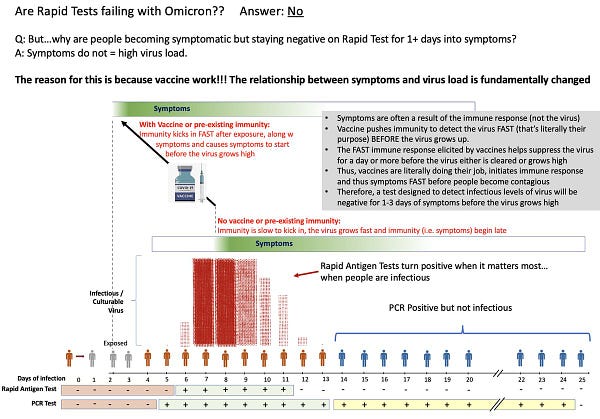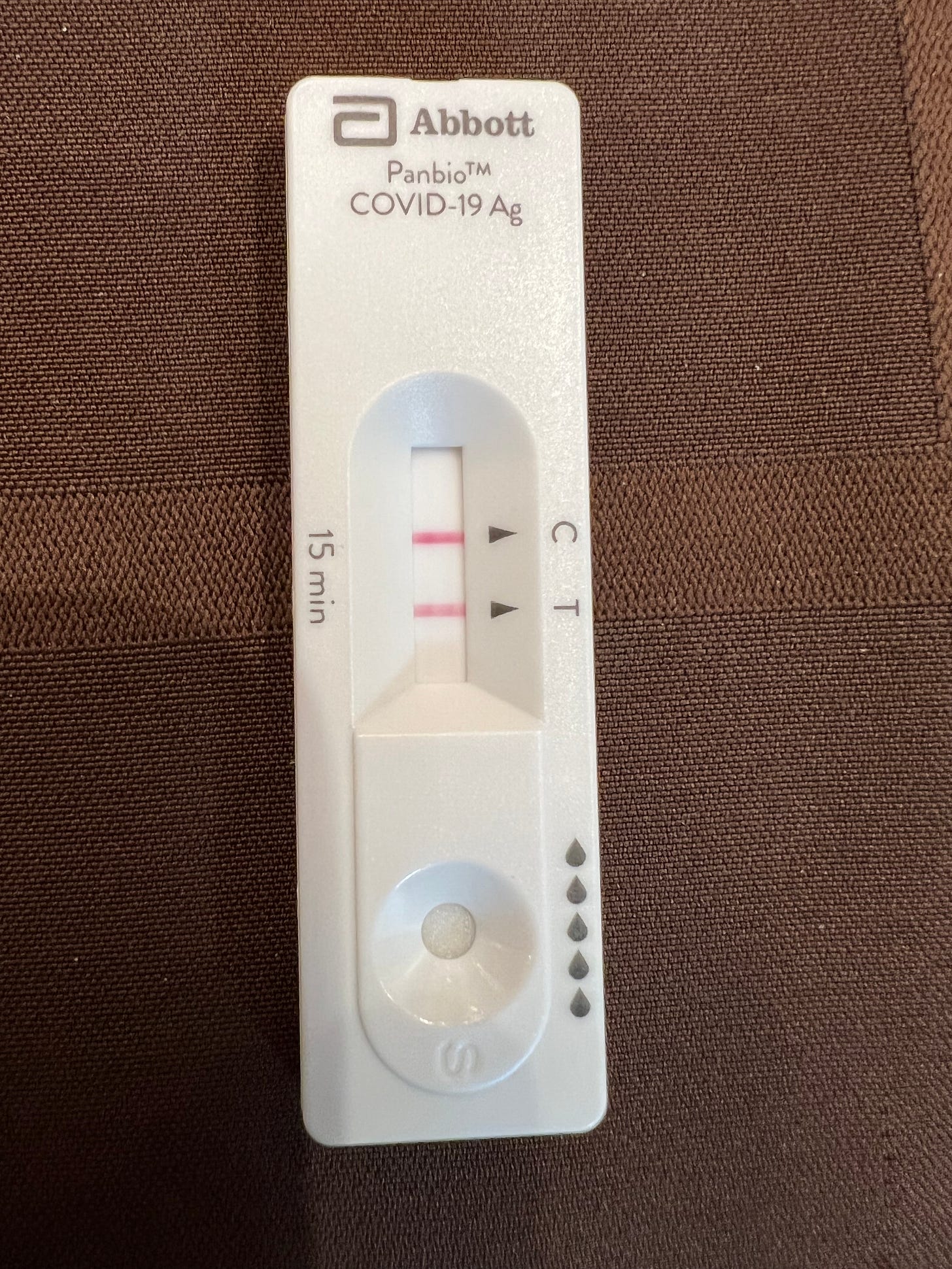We need to adjust how we are using rapid tests
Oh yeah and I finally have Covid
Welcome to Plugging the Gap (my email newsletter about Covid-19 and its economics). In case you don’t know me, I’m an economist and professor at the University of Toronto. I have written lots of books including, most recently, on Covid-19. You can follow me on Twitter (@joshgans) or subscribe to this email newsletter here. (I am also part of the CDL Rapid Screening Consortium. The views expressed here are my own and should not be taken as representing organisations I work for.)
Lots to talk about today. Many have wondered if rapid antigen tests (RATs) are no longer useful because you can have Covid symptoms for a few days before turning positive. That is true. But the key message from today’s post is that this isn’t a reason to give up on RATs but instead we urgently need to double down on them. I had an epiphany on the information problem with Covid as it currently stands. How? Well, I have Covid right now so let me start there.
Covid Reckless
How does one get Covid? Here’s what you do. You fly to Europe for a conference. You spend a day in a hotel conference room with 400 mostly unmasked people. You don’t wear a mask yourself because you are sick of them after having to wear them for 10 hours on a plane. Voila! I was Covid reckless. I knew I was being Covid reckless. And now I have Covid.
Why, after 2 years, take that risk? I felt I needed to train myself to get out there again and given that vaccines do protect from serious illness, now was the right time. I don’t regret the decision. It was good to be at a conference and have dinner conversations with people other than close family.
So what happened? I was at the conference Thursday and flew back on Friday. Thursday will count as day 0 (exposure). On Saturday night, I started to feel sick with a persistent cough and brain fog. That got worse on Sunday (at the level of a modest flu) and continued through Monday. The one thing I can tell you is that real Covid is far worse than psychosomatic Covid that I have had at least 8 times over the last two years.
I tested myself each day from Friday using our stock of RATs. All negative until a faint line appeared on Monday night.
This morning I woke up feeling much better and took another test.
At the CDL Rapid Screening Consortium, we often implicitly celebrate positive test results because they mean we are preventing someone from infecting others. But there I was for 2 days with Covid before the test caught up with what I knew was likely.
Anyhow that positive test result was enough for my children to start treating me like a leper even though I had been coughing for two days previously. But everyone has been testing and none of them are positive yet. But there are some signs. My philosophy is that this is like the flu when you are vaccinated and you don’t isolate in your own house for the flu so the same should apply here. But within household management is a choice for different households. Interestingly, given what I am about to explain below, if you are isolating people just while they have symptoms, you are doing it wrong.
When are you infectious?
Before I get into this, let’s remember I am an economist trying to interpret information that is way outside my field of expertise. So I am going to put it in terms I can understand that will no doubt offend medical professionals. (On that score, please let me know if I get things wrong!)
For Covid Classic all the way up through Delta, the timeline was that you were exposed, the virus replicated inside you, you became infectious, you most likely developed symptoms, the symptoms went away and you were no longer infectious. Back in January, the NYT wondered if it was different and concluded thus:
Now this is just a variant on the usual diagram with Omicron being infectious earlier. But there were no citations on the NYT explainer on this point. It was just a best guess at the time. I think it is likely incorrect in a serious way.
Meanwhile, my experience was that symptoms preceded a positive RAT and for some people even preceded a PCR test. In other words, if we were using tests to indicate whether we were dangerous to others and basing our isolation decisions on them, it appeared that tests were not doing their job. So people might, say, “yes I have a scratchy throat but I took a test and it was negative so I can continue to go to work.” However, they have Covid and so this is precisely the thing public health people were concerned about — they want people to be cautious with any symptom and not feel confident with tests because tests were unreliable.
Here’s the thing, labs evaluated the RATs and they were working just as they were for previous variants. Omicron was a mutation in the spike protein but RATs weren’t operating on that protein anyhow and so were picking up Covid antigens — molecules on the surface of the virus — as well as before. Ah but hang on, those studies were benchmarking RATs with PCR tests as they always do. Was that the whole story?
The other thing happening was that some hypothesised that the antigens (and indeed the virus itself) wasn’t getting to the nose as quickly as before. That remember is where you swab for tests. Some started to use throat swabs for RATs and found detection a day earlier. Moreover, the virus was turning up in wastewater. Thus, maybe the tests were negative because they were looking up the nose as per usual rather than where Omicron was in the body.
Here is Michael Mina:


So what is going on here is that you breathe in the virus and become infected. Your newly vaxxed immune system which is primed for this goes immediately into high gear with the virus fighting your anti-bodies on the upper respiratory tract. That is also preventing the virus from moving throughout the body including to the nose. It is also why you have symptoms because symptoms are really the indicator that your immune system is working.
In other words, symptoms precede positive tests based on nasal swabs. And, moreover, they aren’t telling you that you are contagious …


What tells you that you are contagious? Well, the virus needs to get a place where you are looking for it — aka your nose — and that place has to be a place where you can expel it to do infect others — aka your nose. In other words, when you have a positive RAT, it is telling you exactly what it was telling you before — that you are infectious and should isolate.
Guidance versus Tests
So now the puzzle has a potential resolution. With vaccines, Omicron works a little differently and gives you symptoms before being a danger to others and then, just as you are feeling better, it finally may get to the place where you are dangerous to others.
But here’s the thing: the current guidance does not reflect this reality. Here is the CDC:
If you follow these guidelines, you get symptoms and then run and get tested. That is what I did. The test was negative. So I knew the result and so the CDC would say I am ok to go. It would leave me with the impression that I had a cold rather than Covid and let me tell you, I couldn’t tell the difference.
The problem here is that when you have symptoms is precisely the wrong time to get a test to confirm whether you need to isolate. The time to get the test is a few days after symptoms start. We need people to “test to leave” as symptoms are no indicator of whether you are dangerous and are potentially the opposite.
The right guideline is: if you develop symptoms, wait 5 days following the onset of symptoms (not exposure), get tested and if the test is negative you can end isolation. Otherwise, get tested again every day or so until you are negative.
The Virus Just Won
Part of me is just really impressed with how Omicron has played us. Just as we finally started to accept the use of testing as a way of detecting Covid infectiousness, the virus hard pivots and exploits our information weakness.
We say “we will stay at home with symptoms and a positive test.” The virus says “let’s wait until they are feeling better and not show up on tests while they are sick so that they will just go back to normal while feeling better and that’s when we get ‘em. You think they are going to keep a perfectly fine kid home from school. Ba wa ha.” The virus is exploiting us at our most complacent moment — when we appear to be recovering. The dangerous thing wasn’t being infectious prior to symptoms but being infectious right after symptoms!
Ironically, RATs and PCR tests will work provided they are taken at the right moment. And the right moment is precisely when we feel taking them would be redundant or, at worst, inconvenient because we were trained to think that symptoms equated with contagiousness which wasn’t the case for vaccinated or others with an immune response to Covid. It is a wicked, wicked attack. Impressive, most impressive.
Urgent Changes
The case for RATs or cheap testing is now stronger than it was at any other time during the pandemic precisely because it is the only way to tell if you are infectious. If RATs are hard to get or expensive, then Omicron’s Complacency Attribute will kick in and the virus will spread. If RATs are expected and people understand they need to “test to leave” then we can limit Omicron.
This, however, will require a hard pivot in public health guidelines. I have seen no evidence that there is any serious discussion of this and instead there seems to be a dictum of following “it is what it is.” It does not have to be that way.





